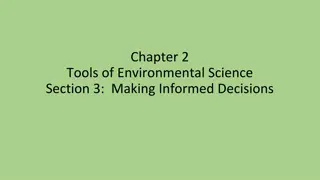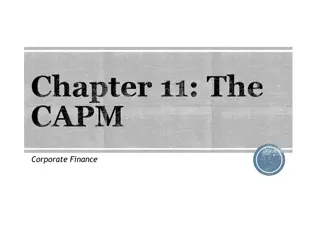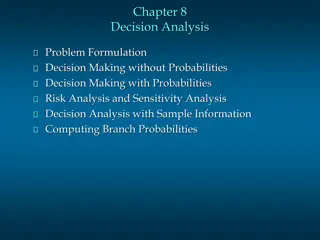Portfolio Decision Analysis in Environmental Management
Portfolio decision analysis plays a crucial role in environmental management by identifying the best set of actions to achieve environmental, societal, and economic objectives within constraints like budget and resources. This approach considers dependencies, synergies, and overall consequences to optimize decision-making. Utilizing portfolio methods can address limitations of standard multicriteria evaluation and enhance the quality of environmental decisions.
Download Presentation

Please find below an Image/Link to download the presentation.
The content on the website is provided AS IS for your information and personal use only. It may not be sold, licensed, or shared on other websites without obtaining consent from the author.If you encounter any issues during the download, it is possible that the publisher has removed the file from their server.
You are allowed to download the files provided on this website for personal or commercial use, subject to the condition that they are used lawfully. All files are the property of their respective owners.
The content on the website is provided AS IS for your information and personal use only. It may not be sold, licensed, or shared on other websites without obtaining consent from the author.
E N D
Presentation Transcript
Supporting Environmental Decision Making with Portfolio Decision Analysis Raimo P. H m l inen, Tuomas J. Lahtinen, Juuso Liesi raimo.hamalainen@aalto.fi, tuomas.j.lahtinen@aalto.fi, juuso.liesio@aalto.fi Systems Analysis Laboratory, Department of Mathematics and Systems Analysis The document can be stored and made available to the public on the open internet pages of Aalto University. All other rights are reserved.
Content Why portfolio methods are needed in environmental management? Review of portfolio approaches A framework for Portfolio Decision Analysis in environmental management An illustrative example with Robust Portfolio Modeling Conclusions
Multicriteria evaluation in environmental decisions 1. Experts and stakeholders develop a number of feasible alternatives with sets of different actions 2. Evaluation of alternatives using standard MCDA This is a heuristic portfolio approach! Problems: Analysis limited to the predetermined alternatives Risk of biases in unaided development of portfolios: champion actions, insensitivity to scope, failure to see synergies and complementaries (Fasolo et al. 2011)
Environmental management decisions are portfolio problems Find the best set of actions with respect to environmental, societal and economical objectives Budget, time and resource constraints Dependencies and synergies of actions Actions can complement each other Bottom line: Overall consequences matter
Example: Climate Stabilization Wedges Game Choose wedges To fill the stabilization triangle Consider economic and social objectives Synergy problems: miles driven, fuel efficiency
Used a lot in practice Examples Create a conservation area consisting of a set of pieces of land Maximize environmental value (Possingham et al. 2000) Invest limited budget to implement several actions that improve the irrigation system Consider climate scenarios and maximize long term profit (Paydar and Qureshi 2012) Photos by Bob Kelly and John Curley CC BY-NC-SA 2.0
Portfolio approaches Multi-criteria decision analysis (standard MCDA) Multi-criteria value-cost analysis Portfolio decision analysis (PDA) Modern portfolio theory Multi-objective optimization Robust Portfolio Modeling
Multi-criteria decision analysis Alternatives = portfolios of actions Alternative A Alternative B Alternative C Multiple objectives Ranking of alternatives Value compositions Objective 1 1 2 3 1 5 7 Objective 2 3 4 5 Value model ? ? = Objective 3 A B C Standard approach Experts develop portfolios together with stakeholders without modelling support Evaluation with an MCDA value model
Simple benefit-cost analysis Take actions with highest benefit-cost ratio until budget cap is reached Heuristic solution to the knapsack problem No modeling of interdependencies or synergies Kleinmuntz (2007)
Modern Portfolio Theory Based on Markowicz (1952) How much resources to each action? (cf. select action or not) Find the efficient resource allocations Benefit and risk: Multicriteria expected benefit and variance calculated with scenarios Example: Marinoni et al. (2011)
Portfolio Decision Analysis (PDA) Combines MCDA with an optimization model Find optimal set of actions: An action is included or not Synergies, interactions and other portfolio constraints included in the model Salo et al. (2011)
Robust Portfolio Modeling PDA with incomplete information Action candidates 1 2 6 Multiple objectives Feasible portfolios Non-dominated portfolios Portfolio A 5 8 Objective 1 3 4 3 7 7 Constraints synergies Portfolio B Objective 2 4 1 Incomplete Information: consequences weights ? ? = Objective 3 6 8 5 Portfolio value model 2 Interval data and ordinal weight information reducing one ton of nitrogen emissions more valuable than reducing two tons of phosphorus Identify non-dominated portfolios and core actions DMs can focus on a reduced set of actions Liesi et al. (2007)
Multi-Objective Optimization Identify non-dominated portfolios Visualize Pareto-frontier What is possible to achieve, what are the trade-offs? Preferences used to select best Stummer and Heidenberger (2003), Zheng and Hobbs (2013)
A portfolio decision analysis framework 1. Define problem context and scope 2. Generate actions and objectives 3. Specify portfolio constraints and consequences 4. Construct the value model 5. Optimize and analyze results
1. Define problem context and scope Problem framing Identify stakeholders Structure the process 2. Generate actions and objectives Generate initial set of objectives and actions Use objectives to generate additional actions Use actions to generate additional objectives Define attributes and measurement scales Specify actions Estimate consequences of actions
3. Specify portfolio constraints and consequences Resource constraints Budget, workforce Performance targets: e.g. reduce emissions by X% Constraints on actions Contingency: B can be selected if A is selected Mutually exclusive: Only C or D can be chosen Synergies and interdepencies How to aggregate consequences? Additive, multiplicative, other? E.g. CO2 reduction from decreased car use depends on fuel efficiency
4. Construct the value model Determine forms of value functions on attributes Elicit weights 5. Optimize and analyze results Communicate and visualize Robustness and sensitivity analysis What is the effect of the budget? What are the core actions? Compare results between stakeholder groups
Illustrative example: Water savings in urban environment Mitchell et al. 2007 A new development: Bridgewater downs is planned near the metropolitan area of Bass, Australia The local water utility Bass Water has decided to consider water saving actions Case analyzed with Robust Portfolio Modeling (RPM) Photos by ykanazawa1999 and Albert Sch ferle CC BY-NC-SA 2.0
Objectives and actions Objectives Reduction in phosphorus release Reduction in nitrogen release Mitigation of climate change Long-run savings Implementation cost Reduction in water demand Actions Nine actions related to Increase of the efficiency of washing machines etc. Raintanks (different sizes and purposes) Recycling water Changes to the piping system 9 actions 511 combinations
Constraints and consequences Budget constraint: Total cost less than B Water reduction constraint: At least X% decrease in water demand Contingency constraint: Extra raintanks can be installed only on top of the basic version Exclusivity constraint 1: Cannot implement both: raintanks for garden use and raintanks for hot water use Total water reduction is multiplicative: Actions 8 and 9 save 34% and 46% water. Together the saving is (1-0.66 x 0.54) x 100%=64%
Things typically looked for Are there? core actions (included in all non-dominated portfolios) exterior actions (not included in any non-dominated portf.) Changes in portfolio composition and performance If a constraint is relaxed If different preference statements are given Cost of including exterior actions? Conclusions: Do we find robust core actions? What is learned?
Value model Additive value function over the overall consequences of the portfolio Weights Case 1: No weights used Case 2: Incomplete weight statements E.g.: One unit of climate change mitigation more valuable than 2 ton/y nitrogen reduction
Three cases analyzed Case 1 No weights used Water demand reduction target 50%. Fixed budget B=45M$. Interval consequence scores (+- 10%) Case 2a Incomplete weight statements Water demand reduction target 50%. Fixed budget B=45M$. Interval consequence scores (+- 10%) Case 2b Incomplete weight statements Water demand reduction target 50%. Budget not fixed. Interval consequence scores (+- 10%)
Case 1 (no weights used) Analysis of results on the RPM interface
Non-dominated portfolios Four portfolios are non-dominated Combinations of six different actions A: (1,2,3,6,9) B: (1,2,3,6,8) C: (1,2,8,9) D: (3,8,9) 1. Efficiency improvement for appliances 1 2. Efficiency improvement for appliances 2 3. Efficiency improvement for appliances 3 4. Water tanks for garden use 5. Extra water tanks for garden and toilet use 6. Water tanks for residential hot water 7. Recycling water for garden and toilet use 8. Acquifer storage for irrigation 9. Large scale dual reticulation Actions 4,5 and 7 not included in any non- dominated portfolio
Performances of non-dominated portfolios Portfolio B best in dollars and climate change mitigation 35 2 0.8 9 8 1.5 0.7 30 7 1 0.6 Climate Change score Phosphorus (tonnes) 25 Nitrogen (tonnes) 6 0.5 0.5 Dollars (M$) 20 5 0 0.4 4 15 -0.5 0.3 3 10 -1 0.2 2 5 -1.5 0.1 1 0 -2 0 0 A B C D A B C D A B C D A B C D Portfolios Portfolios Portfolios Portfolios
Case 2 (Incomplete weight statements) Decision maker says: One unit of climate change mitigation more valuable than 2 ton/y nitrogen reduction 1 ton/y nitrogen reduction is more valuable than 2 ton/y phosphorus reduction 1 ton/y phosphorus reduction is more valuable than 3M$ in NPV 12M$ in NPV is more valuable than one unit of climate change mitigation
Case 2a (Incomplete weight statements, budget 45M$) Result: Portfolio B dominates portfolios A,C and D 1. Efficiency improvement for appliances 1 2. Efficiency improvement for appliances 2 3. Efficiency improvement for appliances 3 4. Water tanks for garden use 5. Extra water tanks for garden and toilet use 6. Water tanks for residential hot water 7. Recycling water for garden and toilet use 8. Acquifer storage for irrigation 9. Large scale dual reticulation Portfolio B: What if budget was different?
Case 2b (Incomplete weight statements, budget not fixed) Non-dominated portfolios calculated with all possible budgets Portfolio B dominates with all budgets between 38M$ and 55M$ Core action (dark green): included in all non- dominated portfolios with given budget Exterior actions (red): not included in any non-dominated portfolio with given budget Same actions 1,2,3,6 and 8 (= portfolio B) are core actions with all budgets 38-55M$
Robust Portfolio Modeling Easy to use Interface Computational support Visualizations Results can be obtained even without precise weights Possible to focus analysis on non-dominated portfolios What if analyses What if budget was increased? What if action A is included in the portfolio?
Conclusions Environmental community starting to realize that environmental decisions require portfolio thinking We need to take the next step: From MCDA evaluation to portfolio analysis Synergies and interdependencies important Challenge to develop ways to engage stakeholders in interactive portfolio analysis Enumeration with Excel feasible with up to 19 actions First step to practice and experiment with role playing students?
Thank you References: Markowitz, H. (1952). Portfolio selection. The journal of finance, 7(1):77 91 Possingham, H., Ball, I., and Andelman, S. (2000). Mathematical methods for identifying representative reserve networks. In Quantitative methods for conservation biology, pages 291 306. Springer. Stummer, C. and Heidenberger, K. (2003). Interactive R&D portfolio analysis with project interdependencies and time profiles of multiple objectives. IEEE Transaction on Engineering Management, 50(2):175 183. Kleinmuntz, D. N. (2007). Resource allocation decisions. In Advances in Decision Analysis: From Foundations to Applications, pp. 400 418. Cambridge University Press. Liesi , J., Mild, P., and Salo, A. (2007). Preference programming for robust portfolio modeling and project selection. European Journal of Operational Research, 181(3):1488 1505 Mitchell, C., Fane, S., Willetts, J., Plant, R., and Kazaglis, A. (2007). Costing for sustainable outcomes in urban water systems: A guidebook. CRC for Water Quality and Treatment. Hotinski, Roberta. (2009) Stabilization Wedges: A Concept & Game. Princeton University: http://cmi.princeton.edu/wedges/ Fasolo, Barbara, Alec Morton, and Detlof von Winterfeldt. Behavioural issues in portfolio decision analysis. Springer New York, 2011. Marinoni, O., Adkins, P., and Hajkowicz, S. (2011). Water planning in a changing climate: Joint application of cost utility analysis and modern portfolio theory. Environmental Modelling & Software, 26(1):18 29. Salo, A., Keisler, J., and Morton, A. (2011). Portfolio Decision Analysis. Springer.
Paydar, Z. and Qureshi, M. E. (2012). Irrigation water management in uncertain conditions: application of modern portfolio theory. Agricultural Water Management, 115:47 54. Convertino, M. and Valverde Jr, L. J. (2013). Portfolio decision analysis framework for value-focused ecosystem management. PloS one, 8(6):e65056. Lehtom ki, J. and Moilanen, A. (2013). Methods and workflo wfo rspatia lconservatio nprioritizatio nusin gzonation. Environmental Modelling & Software, 47:128 137. Zheng, P. Q. and Hobbs, B. F. (2013). Multiobjective portfolio analysis of dam removals addressing dam safety, fish populations, and cost. Journal of Water Resources Planning and Management, 139(1):65 75. Kreitler, J., Stoms, D. M., and Davis, F. W. (2014). Optimization in the utility maximization framework for conservation planning: a comparison of solution procedures in a study of multifunctional agriculture. PeerJ, 2:e690.





















